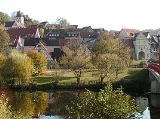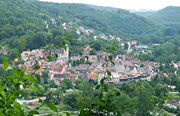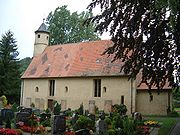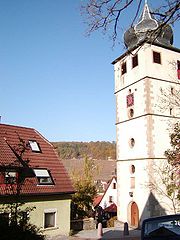
Forchtenberg
Encyclopedia
Forchtenberg is a town in the district of Hohenlohekreis, northern Baden-Württemberg
. It lies on the side of a partly fortified hill overlooking the Kocher valley where the Kupfer river flows into the Kocher
. The name Forchtenberg is derived from "vor dem Berg" or "before the hill" in English.

.
Forchtenberg itself was first mentioned in records in 1298, some 70 years after Count Konrad von Dürn established a fortress on the same hill. The people in Wülfingen, weary of constant flooding from the Kocher river, established the town of Forchtenberg under the fortress on the hill where it stands today. After this time the Valley Church served mainly as a cemetery, as is still the case to this very day. The name Forchtenberg is derived from "vor dem Berg" or "before the hill" in English.
On the death of the Count of Dürn the town was reallocated to territory of Hohenlohe
. Later, as a result of German Mediatisation
, Hohenlohe territories became part of the kingdom of Württemberg
. Forchtenberg was allocated to the Oberamt or higher court of Öhringen
, which became the District of Öhringen in 1938.
 Medieval trade and peddling of wine, hides and related wares was fostered by the presence of the Kocher river which is believed also to have linked into ancient trading routes extending as far as Nuremberg
Medieval trade and peddling of wine, hides and related wares was fostered by the presence of the Kocher river which is believed also to have linked into ancient trading routes extending as far as Nuremberg
in the east and Neuenstadt and Heidelberg
in the west. Regional development was promoted further in 1926 when the first railway was built along the Kocher valley, for the first time connecting Forchtenberg directly to Waldenburg (Württemberg) and beyond. As a result there was a sharp rise in local business. Kreisreform (county boundary reforms) in 1972 moved Forchtenberg back under the jurisdiction of the new Hohenlohe
district.
 In 1981 the railway was dismantled. In the years that followed, the track was gravelled over. It is now a popular cycle route used by tourists of all ages in the summer months.
In 1981 the railway was dismantled. In the years that followed, the track was gravelled over. It is now a popular cycle route used by tourists of all ages in the summer months.
had already taken effect before this time in the area, the town returned to Catholic line of Hohenlohe-Waldenburg-Bartenstein. Despite this, the people of Sindringen remained loyal to the Protestant confession, mainly due to outside military support.
On his retirement in 2004, Martin Tuffentsammer was the longest serving mayor in South Germany.
slaying the silver dragon.
.
in Forchtenberg. In the district of Ernsbach there is an independent primary school.
There are Kindergarten
s in Forchtenberg itself as well as Sindringen and Ernsbach.

and Sophie Scholl
.
Sindringen also boasts many buildings dating back to the Middle Ages with partically renovated town walls. The Town Mill in Sindringen and Sindringen Castle (which is now in private ownership) are also popular tourist spots.

The father of Hans and Sophie Scholl, Robert Scholl, served as mayor in Forchtenberg from 1919 to 1929 where both children spent most of their childhood.
Baden-Württemberg
Baden-Württemberg is one of the 16 states of Germany. Baden-Württemberg is in the southwestern part of the country to the east of the Upper Rhine, and is the third largest in both area and population of Germany's sixteen states, with an area of and 10.7 million inhabitants...
. It lies on the side of a partly fortified hill overlooking the Kocher valley where the Kupfer river flows into the Kocher
Kocher
The Kocher is a 168 km long right tributary of the Neckar in the north-eastern part of Baden-Württemberg, Germany. The name "Kocher" originates from its Celtic name "cochan" and probably means winding, meandering river. The Kocher rises in the eastern foothills of the Swabian Alb from two karst...
. The name Forchtenberg is derived from "vor dem Berg" or "before the hill" in English.
Geography
Forchtenberg lies on north-facing hill overlooking the Kocher and Kupfer rivers. To the south of Forchtenberg the hills rise higher to woodland and the Hohenlohe plateau beyond. To the north runs the long Kocher valley. Opposite Forchtenberg the hills are a rich tapestry of south-facing vineyards.
Administrative districts
Forchtenberg encompasses a number of communities: Forchtenberg itself, Sindringen, Ernsbach, Wohlmuthausen and Muthof. A number of outlying hamlets also fall under the town of Forchtenberg: Büschelhof, Haberhof, Hohensall, Metzdorf, Neuwülfingen, Orbachshof, Rauhbusch, Schießhof, Schleierhof, Schwarzenweiler and Waldfeld.History
Forchtenberg was originally established as an off-shoot from the hamlet of Wülfingen (which lies on the opposite side of the Kocher river to the hill on which Forchtenberg stands today). According to the wooden plaque found on the cemetery church in Wülfingen, like many settlements in the area near the Limes Romanus, prior to 250 AD the area around Forchtenberg housed a pagan Alemani community. The original Christian church in the old valley site dated back to 536 AD when the settlement fell into the hands of the FranksFranks
The Franks were a confederation of Germanic tribes first attested in the third century AD as living north and east of the Lower Rhine River. From the third to fifth centuries some Franks raided Roman territory while other Franks joined the Roman troops in Gaul. Only the Salian Franks formed a...
.
Forchtenberg itself was first mentioned in records in 1298, some 70 years after Count Konrad von Dürn established a fortress on the same hill. The people in Wülfingen, weary of constant flooding from the Kocher river, established the town of Forchtenberg under the fortress on the hill where it stands today. After this time the Valley Church served mainly as a cemetery, as is still the case to this very day. The name Forchtenberg is derived from "vor dem Berg" or "before the hill" in English.
On the death of the Count of Dürn the town was reallocated to territory of Hohenlohe
Hohenlohe
Hohenlohe is the name of a German princely family and the name of their principality.At first rulers of a county, its two branches were raised to the rank of principalities of the Holy Roman Empire in 1744 and 1764 respectively; in 1806 they lost their independence and their lands formed part of...
. Later, as a result of German Mediatisation
German Mediatisation
The German Mediatisation was the series of mediatisations and secularisations that occurred in Germany between 1795 and 1814, during the latter part of the era of the French Revolution and then the Napoleonic Era....
, Hohenlohe territories became part of the kingdom of Württemberg
Württemberg
Württemberg , formerly known as Wirtemberg or Wurtemberg, is an area and a former state in southwestern Germany, including parts of the regions Swabia and Franconia....
. Forchtenberg was allocated to the Oberamt or higher court of Öhringen
Öhringen
Öhringen is the largest city in Hohenlohe in the state of Baden-Württemberg, in southwest Germany, near Heilbronn. Öhringen is on the railways to Schwäbisch Hall and Crailsheim.With a population of 22,745 , the city is diverse...
, which became the District of Öhringen in 1938.

Nuremberg
Nuremberg[p] is a city in the German state of Bavaria, in the administrative region of Middle Franconia. Situated on the Pegnitz river and the Rhine–Main–Danube Canal, it is located about north of Munich and is Franconia's largest city. The population is 505,664...
in the east and Neuenstadt and Heidelberg
Heidelberg
-Early history:Between 600,000 and 200,000 years ago, "Heidelberg Man" died at nearby Mauer. His jaw bone was discovered in 1907; with scientific dating, his remains were determined to be the earliest evidence of human life in Europe. In the 5th century BC, a Celtic fortress of refuge and place of...
in the west. Regional development was promoted further in 1926 when the first railway was built along the Kocher valley, for the first time connecting Forchtenberg directly to Waldenburg (Württemberg) and beyond. As a result there was a sharp rise in local business. Kreisreform (county boundary reforms) in 1972 moved Forchtenberg back under the jurisdiction of the new Hohenlohe
Hohenlohe
Hohenlohe is the name of a German princely family and the name of their principality.At first rulers of a county, its two branches were raised to the rank of principalities of the Holy Roman Empire in 1744 and 1764 respectively; in 1806 they lost their independence and their lands formed part of...
district.

Sindringen
Sindringen was first mentioned in records in 1323 when the rulers of Weinsberg awarded the community the status of a town. Although the ReformationProtestant Reformation
The Protestant Reformation was a 16th-century split within Western Christianity initiated by Martin Luther, John Calvin and other early Protestants. The efforts of the self-described "reformers", who objected to the doctrines, rituals and ecclesiastical structure of the Roman Catholic Church, led...
had already taken effect before this time in the area, the town returned to Catholic line of Hohenlohe-Waldenburg-Bartenstein. Despite this, the people of Sindringen remained loyal to the Protestant confession, mainly due to outside military support.
Burgomasters / Mayors
- Circa mid 18th century Johanns Georg Matheus Haag
- Circa 1810 Village Mayor Haag
- Circa 1820-1837 von Olnhausen
- 1837-1847 Schall (notary)
- 1847-1860 Ludwig Blanck
- 1860-1872 Walther (notary)
- 1872-1876 Karl Krauß
- 1876-1892 Karl Böhringer
- 1892-1900 Paul Hüzel
- 1900-1906 Christian Wirth
- 1906-1919 Hermann Hörer
- 1919-1930 Robert SchollRobert SchollRobert Scholl was a Württembergian politician and father of Hans and Sophie Scholl. Scholl was a liberal and a critic of the Nazi regime. He also co-founded the All-German People's Party after the war.-Personal life:...
- 1930-1933 Friedrich Kramer
- 1933-1936 Eugen Maurer
- 1936-1945 Adolf Hebeiß (represented 1942-1945 by Richard Leitlein)
- 1946-1948 Wilhelm Wolf
- 1948-1948 Friedrich Haag
- 1948-1966 Adolf Hebeiß
- 1966-2004 Martin Tuffentsammer
- 2004-today Uwe Gysin
On his retirement in 2004, Martin Tuffentsammer was the longest serving mayor in South Germany.
Coat of arms
The coat of arms depicts the silver, winged, armoured character of Michael (archangel)Michael (archangel)
Michael , Micha'el or Mîkhā'ēl; , Mikhaḗl; or Míchaël; , Mīkhā'īl) is an archangel in Jewish, Christian, and Islamic teachings. Roman Catholics, Anglicans, and Lutherans refer to him as Saint Michael the Archangel and also simply as Saint Michael...
slaying the silver dragon.
Economy and infrastructure
Forchtenberg is a traditional wine-growing area within the Kocherberg region of Kocher-Jagst-Tauber.Transportation
Forchtenberg's main connection to neighbouring communities is provided by the Kocher valley road which runs East to West. A regular bus services runs between Forchtenberg, its outlying communities and the towns of Öhringen and KünzelsauKünzelsau
Künzelsau[p] is a town in Baden-Württemberg, in south central Germany. It is the capital of the Hohenlohe district. It is located on the river Kocher, 19 km north of Schwäbisch Hall, and 37 km northeast of Heilbronn....
.
Schools in Forchtenberg
There is a Primary School Grundschule and Senior School HauptschuleHauptschule
A Hauptschule is a secondary school in Germany and Austria, starting after 4 years of elementary schooling, which offers Lower Secondary Education according to the International Standard Classification of Education...
in Forchtenberg. In the district of Ernsbach there is an independent primary school.
There are Kindergarten
Kindergarten
A kindergarten is a preschool educational institution for children. The term was created by Friedrich Fröbel for the play and activity institute that he created in 1837 in Bad Blankenburg as a social experience for children for their transition from home to school...
s in Forchtenberg itself as well as Sindringen and Ernsbach.
Sport and leisure
Forchtenberg, Ernsbach and Sindringen all have their own sports halls and community centres. The old gymnastics halls in Forchtenberg and Sindringen are supported by an active sports clubs which organise regaular tournaments and events.People, culture and architecture
A number of cultural events take place every year in the 'Ernsbacher Kelter' with the backing of the local town council. To a certain degree the Ernsbacher Kelter has developed in recent years into a default community centre.
Museums
The building housing the Kern Haus historical museum in Forchtenberg dates back to 1470. For 3 generations it was home to the Kern family of artists. It subsequently provided working premises for local stonemasons and sculptors who mined stones from the local hills to sculpt statues for the surrounding region. The museum also documents the life and times of HansHans Scholl
Hans Fritz Scholl was a founding member of the White Rose resistance movement in Nazi Germany.-Biography:...
and Sophie Scholl
Sophie Scholl
Sophia Magdalena Scholl was a German student, active within the White Rose non-violent resistance group in Nazi Germany. She was convicted of high treason after having been found distributing anti-war leaflets at the University of Munich with her brother Hans...
.
Local architecture
The centre of Forchtenberg dates back to the Middle Ages surrounded by partially intact, partially renovated fortifications. This includes the Town Hall which was home to many local dignitaries including the Scholl family. Over the old town lies the ruins of the old fortress including a large vaulted cellar. Down the valley from the old town stands the former gypsum quarry. The entire old town of Forchtenberg is subject to a preservation order which also extends to the ruined fortress on the hill and the Valley Church cemetery.Sindringen also boasts many buildings dating back to the Middle Ages with partically renovated town walls. The Town Mill in Sindringen and Sindringen Castle (which is now in private ownership) are also popular tourist spots.
Regular events
- Forchtenberg old town is home to an annual mediaeval Christmas market on every first weekend of Advent.
- In May every year Sindringen is home to a large pottery market which is attended by potters from all over Europe.
- Every July the Christian Rock in the Ruins Openair Festival takes place in the old hill ruins.
- At the end of July/beginning of August the old hill ruins are home to an open air cinema.
Famous people from Forchtenberg
- Leonhard Kern (1588–1662) German sculptor
- Johann (later John) Christian Wohlmann (1745–1825) London gold and silver refiner
- Hans Gradmann (1892–1983) German botanist
The Scholl family

- Sophie SchollSophie SchollSophia Magdalena Scholl was a German student, active within the White Rose non-violent resistance group in Nazi Germany. She was convicted of high treason after having been found distributing anti-war leaflets at the University of Munich with her brother Hans...
, important member of the German White RoseWhite RoseThe White Rose was a non-violent/intellectual resistance group in Nazi Germany, consisting of students from the University of Munich and their philosophy professor...
resistance movement. Born 9 May 1921, executed by the Nazis on 22 February 1943 in MunichMunichMunich The city's motto is "" . Before 2006, it was "Weltstadt mit Herz" . Its native name, , is derived from the Old High German Munichen, meaning "by the monks' place". The city's name derives from the monks of the Benedictine order who founded the city; hence the monk depicted on the city's coat...
. - Hans SchollHans SchollHans Fritz Scholl was a founding member of the White Rose resistance movement in Nazi Germany.-Biography:...
important member of the German White Rose resistance movement. Born in IngersheimIngersheimIngersheim is a town in the district of Ludwigsburg in Baden-Württemberg in Germany....
22 September 1918, also executed by the Nazis on 22 February 1943 in MunichMunichMunich The city's motto is "" . Before 2006, it was "Weltstadt mit Herz" . Its native name, , is derived from the Old High German Munichen, meaning "by the monks' place". The city's name derives from the monks of the Benedictine order who founded the city; hence the monk depicted on the city's coat...
.
The father of Hans and Sophie Scholl, Robert Scholl, served as mayor in Forchtenberg from 1919 to 1929 where both children spent most of their childhood.

